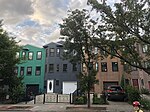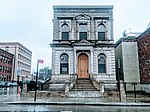Public Bath No. 7
1906 establishments in New York CityBrooklyn Registered Historic Place stubsBrooklyn building and structure stubsBuildings and structures in BrooklynGovernment buildings completed in 1906 ... and 5 more
Government buildings on the National Register of Historic Places in New York CityNational Register of Historic Places in BrooklynNew York City Designated Landmarks in BrooklynPark SlopeRomanesque Revival architecture in New York City

Public Bath No. 7 is a historic bathhouse located in Park Slope, Brooklyn, New York City. It was designed by Brooklyn architect Raymond F. Almirall. It was built between 1906 and 1910 and is constructed of white glazed brick and limestone colored terra cotta blocks. The design is based on a Renaissance palazzo. It measures three bays by five bays. The bathhouse was converted to a gymnasium in 1937.It was listed on the National Register of Historic Places in 1985.In the 1990s it was converted to a private events space and renamed The Lyceum.In 2014 the property was lost to foreclosure.In 2017 the building finished restoration.
Excerpt from the Wikipedia article Public Bath No. 7 (License: CC BY-SA 3.0, Authors, Images).Public Bath No. 7
President Street, New York Brooklyn
Geographical coordinates (GPS) Address Nearby Places Show on map
Geographical coordinates (GPS)
| Latitude | Longitude |
|---|---|
| N 40.676666666667 ° | E -73.983333333333 ° |
Address
President Street 586
11215 New York, Brooklyn
New York, United States
Open on Google Maps



